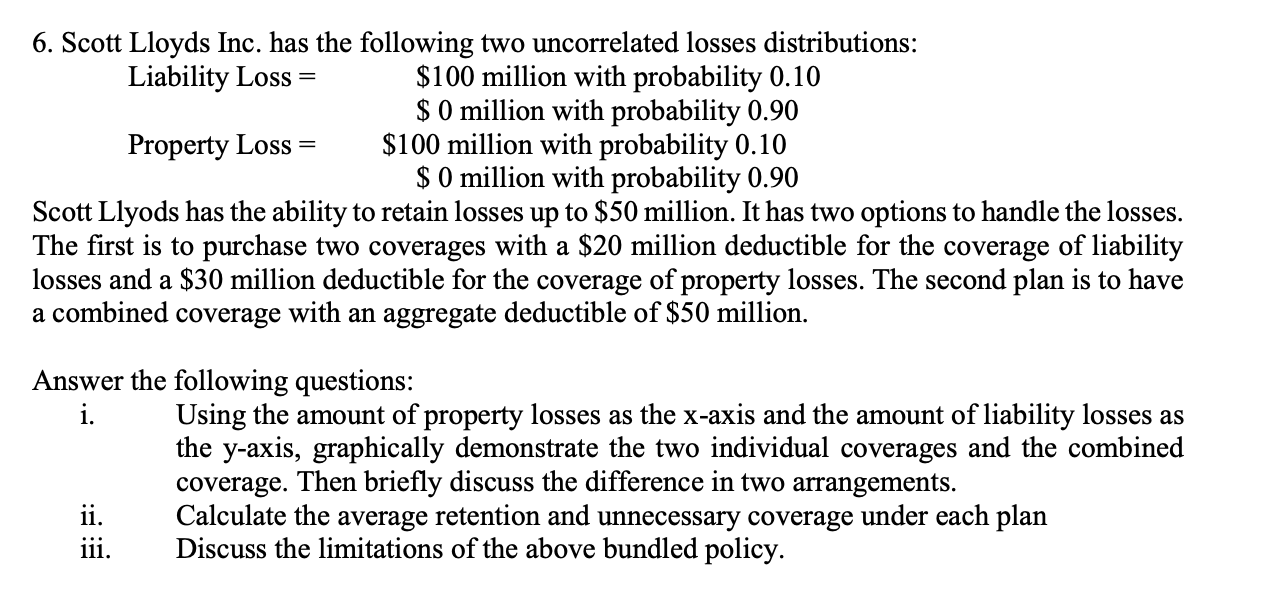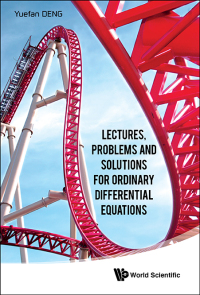

5. Use the finite risk contract described in the text. Suppose that a 3-year contract is signed that (1) requires the insured firm to pay premiums of $4 million a year, (2) credit interest at 6.0% percent annually on the year's beginning balance, (3) provides the insurer with a fee equal to 10 percent of each premium, and (4) has an aggregate limit of $20 million for the three years. How much would the policyholder get back at the end of three years if loss payments at year-end were a) $3 million in year 1; $3 million in year 2; and $3 million in year 3? b) $8 million in year 1; $1 million in year 2; and $1 million in year 3? Then discuss the benefit of the finite risk contract. 6. Scott Lloyds Inc. has the following two uncorrelated losses distributions: Liability Loss = $100 million with probability 0.10 $ 0 million with probability 0.90 Property Loss = $100 million with probability 0.10 $ 0 million with probability 0.90 Scott Llyods has the ability to retain losses up to $50 million. It has two options to handle the losses. The first is to purchase two coverages with a $20 million deductible for the coverage of liability losses and a $30 million deductible for the coverage of property losses. The second plan is to have a combined coverage with an aggregate deductible of $50 million. Answer the following questions: i. Using the amount of property losses as the x-axis and the amount of liability losses as the y-axis, graphically demonstrate the two individual coverages and the combined coverage. Then briefly discuss the difference in two arrangements. ii. Calculate the average retention and unnecessary coverage under each plan iii. Discuss the limitations of the above bundled policy. 5. Use the finite risk contract described in the text. Suppose that a 3-year contract is signed that (1) requires the insured firm to pay premiums of $4 million a year, (2) credit interest at 6.0% percent annually on the year's beginning balance, (3) provides the insurer with a fee equal to 10 percent of each premium, and (4) has an aggregate limit of $20 million for the three years. How much would the policyholder get back at the end of three years if loss payments at year-end were a) $3 million in year 1; $3 million in year 2; and $3 million in year 3? b) $8 million in year 1; $1 million in year 2; and $1 million in year 3? Then discuss the benefit of the finite risk contract. 6. Scott Lloyds Inc. has the following two uncorrelated losses distributions: Liability Loss = $100 million with probability 0.10 $ 0 million with probability 0.90 Property Loss = $100 million with probability 0.10 $ 0 million with probability 0.90 Scott Llyods has the ability to retain losses up to $50 million. It has two options to handle the losses. The first is to purchase two coverages with a $20 million deductible for the coverage of liability losses and a $30 million deductible for the coverage of property losses. The second plan is to have a combined coverage with an aggregate deductible of $50 million. Answer the following questions: i. Using the amount of property losses as the x-axis and the amount of liability losses as the y-axis, graphically demonstrate the two individual coverages and the combined coverage. Then briefly discuss the difference in two arrangements. ii. Calculate the average retention and unnecessary coverage under each plan iii. Discuss the limitations of the above bundled policy








